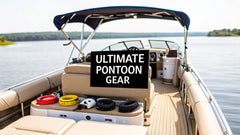Your Guide to the Best Boat Vinyl Cleaner
If you've ever thought about grabbing an all-purpose cleaner from under the kitchen sink to quickly wipe down your boat seats, stop right there. That's one of the most common—and most damaging—mistakes I see boat owners make.
Using the wrong cleaner on your marine vinyl can strip its protective oils, which is a fast track to cracking, fading, and even mildew growth. Your boat needs a dedicated boat vinyl cleaner because the stuff is in a constant battle with UV rays, saltwater, and humidity that household products just aren't built to handle.
Why Your Boat Vinyl Needs Specialized Care
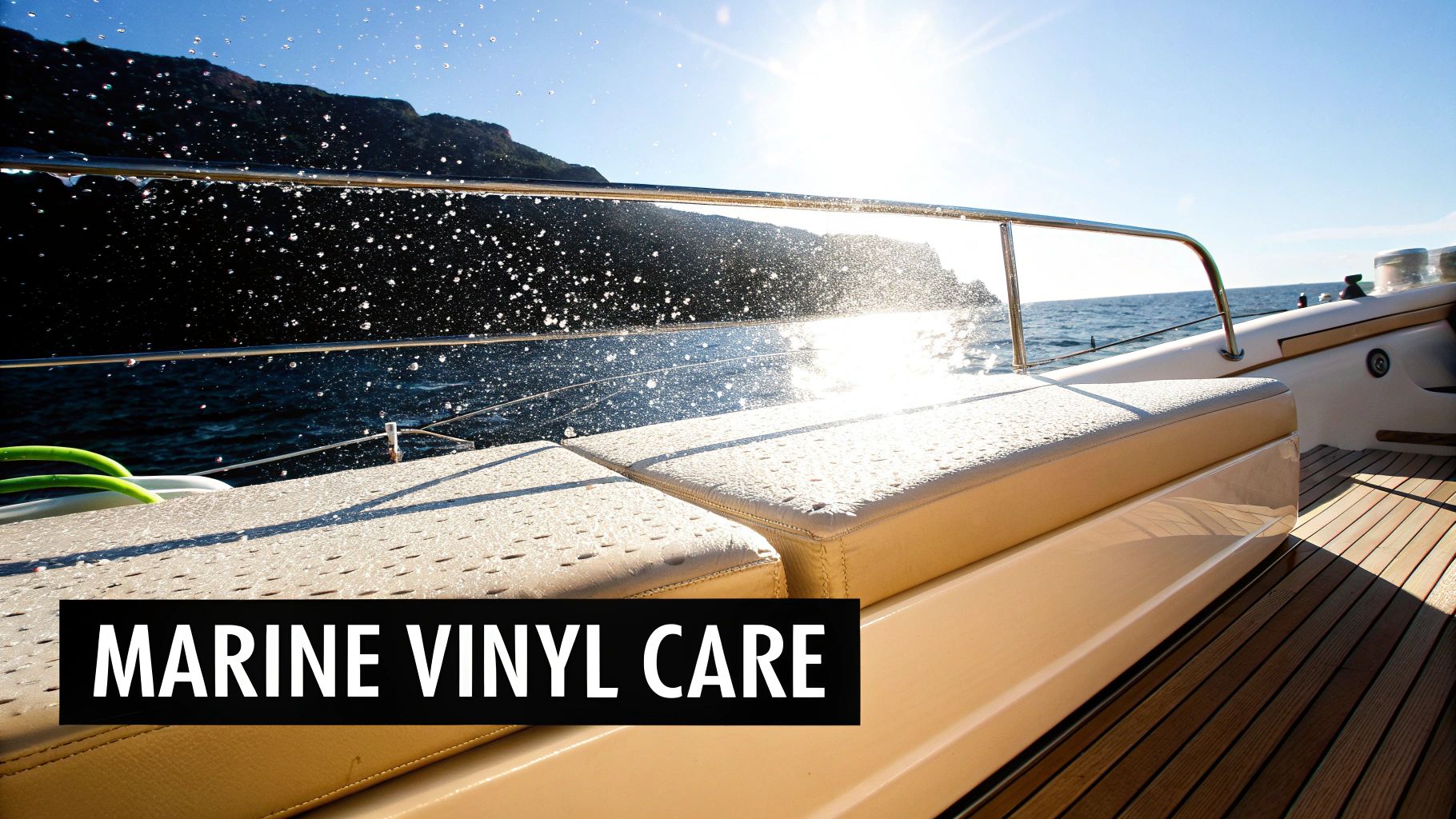
Your boat's vinyl upholstery isn't just fabric; it's a high-performance material specifically engineered for a harsh life on the water. Unlike the cushions on your couch, marine vinyl is constantly exposed to the elements.
Think about what a single day out on the boat does to your seats. They're getting baked by the sun, sprayed with corrosive salt, and then sitting in damp, humid air. It’s a brutal combination that regular cleaning products simply can't cope with.
The Dangers of Household Cleaners
It’s tempting, I get it. But grabbing that bottle of kitchen spray is a terrible idea. Most household cleaners pack a punch with harsh chemicals like bleach, ammonia, or abrasive powders that can cause serious, permanent damage to your boat’s vinyl.
These chemicals literally suck the life out of your vinyl by stripping away the essential plasticizers that keep it soft and flexible. Before you know it, your seats become brittle and stiff, leading to ugly cracks and splits. They can also destroy the factory topcoat, leaving the material completely exposed to stains and sun damage.
The Unique Challenges of the Marine Environment
Life on the water throws a unique set of problems at your boat, and you need a cleaner formulated to deal with them head-on, without causing more harm than good.
Here’s what a proper boat vinyl cleaner is designed to tackle:
- UV Radiation: The sun is public enemy number one for your vinyl, causing fading and breaking down the material over time. Good marine cleaners will prep the surface for a UV protectant spray, which is a critical follow-up step.
- Saltwater Corrosion: When saltwater evaporates, it leaves behind abrasive salt crystals that grind away at your vinyl. A quality cleaner will safely dissolve and lift these deposits away.
- Mold and Mildew: All that moisture is a breeding ground for mold and mildew. Once those spores get into the grain of your vinyl, they’re tough to get out. Specialized cleaners have agents that kill the spores without wrecking the material.
Look, protecting your investment is about more than just keeping things pretty. Well-maintained vinyl doesn't just look better; it holds up longer, which directly impacts your boat's resale value and saves you from a very expensive reupholstery job down the road.
This isn't just my opinion; the market reflects it. The boat cleaner market, which includes specialized products like a boat vinyl cleaner, was valued at around $410 million and is on the rise. It just goes to show how many boaters are realizing the importance of using the right stuff. You can read more about the boat cleaner market trends to see just how fast it's growing.
Choosing the Right Boat Vinyl Cleaner
Walking down the cleaning aisle at a marine supply store can be overwhelming. With a sea of options all claiming to be the best boat vinyl cleaner, how do you pick the right one? The secret isn't finding one magic bottle for everything. It's about understanding what your vinyl actually needs right now.
Think about it this way: the product you need for a quick wipe-down after a sunny day on the lake is worlds apart from the one required to battle deep-set mildew stains after a damp winter in storage.
Your first step is always to take a good look at your seats and upholstery. Are you just dealing with a bit of dust and a few fresh scuffs? Or are you staring down ugly, black mildew spots that have worked their way into the vinyl's grain? Your answer here will guide your entire cleaning strategy.
Matching the Cleaner to the Job
Not all cleaners are built the same. They fall into a few distinct categories, each formulated for a specific task. Using the wrong one can be a waste of time at best and cause real damage at worst. It's like using a sledgehammer to hang a picture frame—you need the right tool for the job.
- pH-Neutral Cleaners: These are your go-to for daily or weekly upkeep. Gentle and safe for frequent use, they’re perfect for routine cleanups. They'll lift light dirt, sunscreen residue, and salt spray without stripping the vinyl's protective topcoat.
- Heavy-Duty Cleaners: When you’re facing tough grime, ground-in dirt, or the dreaded mildew, you need more muscle. These cleaners have stronger formulas designed to break down stubborn stains, but you need to use them carefully and follow the directions.
- All-in-One Cleaner & Protectants: These products are all about convenience. They clean the vinyl while leaving behind a thin layer of UV protection, tackling two jobs at once. They are excellent for regular maintenance but might not have the power needed for a full restoration project.
The demand for these specialized products is booming. Market forecasts predict the boat vinyl cleaner industry will hit around $750 million, thanks to a rise in boat ownership and more people understanding the importance of proper maintenance.
To help you decide which type of cleaner is right for your situation, we've put together a simple comparison.
Comparing Boat Vinyl Cleaner Types
Choosing between a gentle daily cleaner and a heavy-duty mildew remover can make all the difference. This table breaks down the main types of vinyl cleaners to help you pinpoint the best option for whatever cleaning challenge you're facing.
| Cleaner Type | Best For | Key Features | When to Avoid |
|---|---|---|---|
| pH-Neutral Daily Cleaner | Light dirt, dust, sunscreen, salt spray, post-trip wipe-downs | Gentle formula, safe for frequent use, won't strip protective coatings | Deep-set stains, heavy mildew, or ground-in grime |
| Heavy-Duty Stain/Mildew Remover | Stubborn mildew, black spots, ground-in dirt, tough stains | Strong formula, breaks down organic stains, deep cleans textured vinyl | Routine cleaning, sensitive or older vinyl, or without proper rinsing |
| All-in-One Cleaner & Protectant | Regular maintenance, light cleaning, adding UV protection | Saves time, provides a protective barrier, enhances appearance | Heavy-duty cleaning jobs, removing embedded stains, or prepping for a new protectant |
Ultimately, having more than one type on hand is the best strategy. Use the gentle stuff for routine care and save the heavy-duty cleaner for when you really need it.
This visual guide breaks down the selection process into a clear, three-step flow.
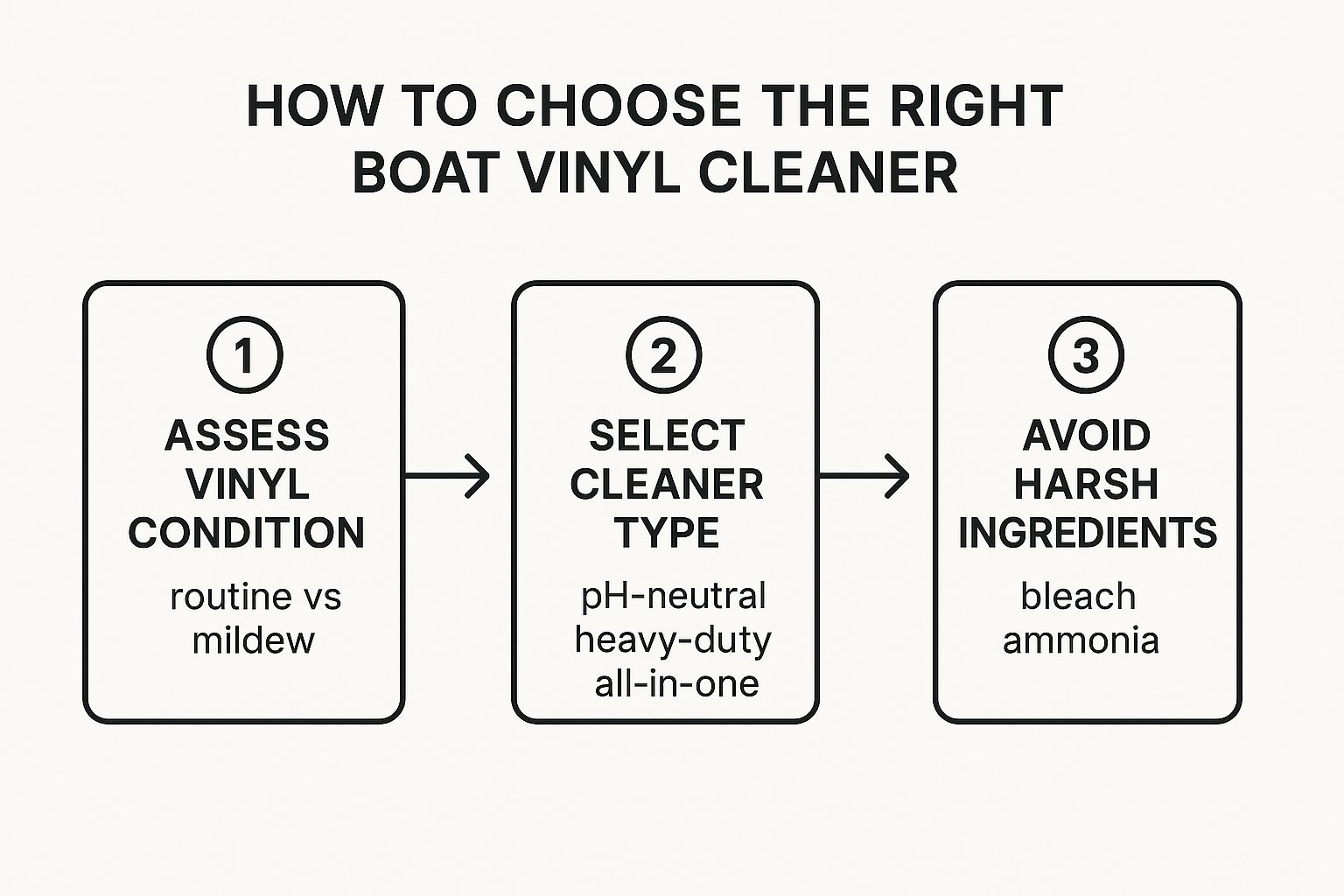
As the infographic shows, it all starts with assessing your vinyl's condition. That tells you what cleaner to grab, while always remembering to avoid the ingredients that can cause permanent damage.
Ingredients to Avoid at All Costs
Just as important as what's in your cleaner is what's not in it. Certain chemicals are notorious for destroying marine vinyl, making it brittle, discolored, and prone to cracking over time. Reading the label isn't just a good idea—it's non-negotiable.
Critical Tip: Never, ever use a product containing bleach or ammonia on your boat’s vinyl. Bleach will dry out the material and ruin its chemical structure, while ammonia-based cleaners strip away the essential oils that keep vinyl soft and flexible.
Even some popular household cleaners like Simple Green can be too harsh for repeated use on marine-grade materials. Your safest bet is always to choose a product specifically labeled as a boat vinyl cleaner.
To help narrow down your options, check out our comprehensive guide on the best boat vinyl cleaner options available today. It will give you a curated list of products that have been proven to work safely and effectively on boat upholstery.
The Right Way to Clean Your Boat's Vinyl
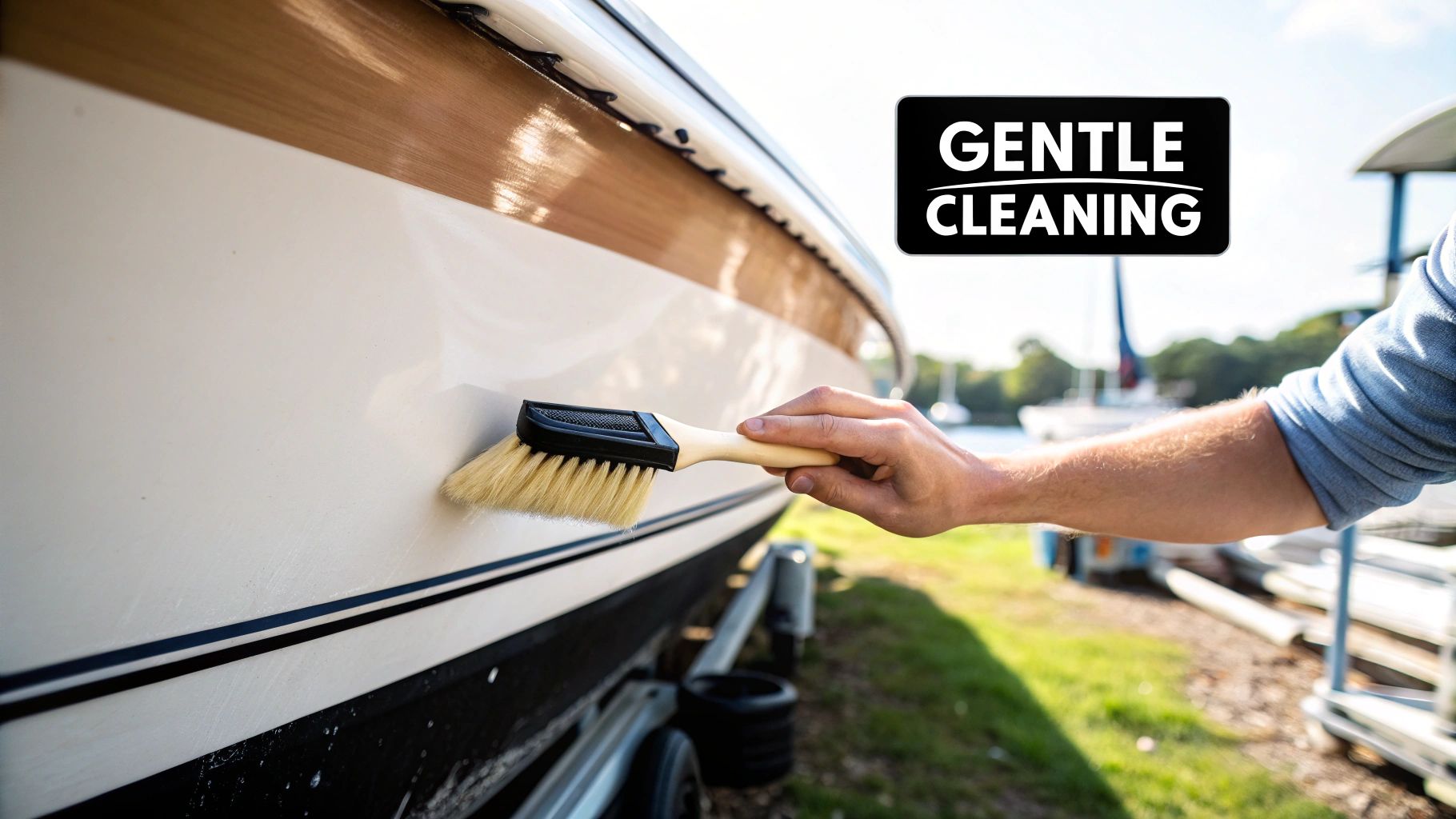
Having the perfect boat vinyl cleaner is a solid first step, but it’s your technique that really separates a decent job from a professional-grade finish. The right approach not only gets your vinyl spotless but also protects it from accidental damage, keeping those seats looking sharp season after season.
Think of it like painting a room—you wouldn't just slap paint on the wall without prepping it first. The same idea applies here. It's the small details that make all the difference.
Setting the Stage for Success
Before you even pop the top on your cleaner, take a second to set up your workspace. The absolute number one rule is to avoid direct sunlight. Trying to clean vinyl under a blazing sun is just asking for trouble. The heat causes the cleaner to evaporate almost instantly.
When the cleaner dries that fast, it doesn't have time to actually break down the grime. Even worse, it often leaves a sticky, streaky mess that’s a real pain to get off. For the best results, always work in the shade, under a cover, or wait for an overcast day.
Also, give the area a quick pre-rinse. A light spray with fresh water will knock off any loose dirt, salt crystals, and other surface gunk. This simple step keeps you from grinding those abrasive bits into the vinyl when you start scrubbing.
The Art of Gentle Agitation
Now you're ready to apply your boat vinyl cleaner. Instead of soaking an entire seat, work in small, manageable sections—about two to three square feet at a time. This controlled method keeps the cleaner wet and active, letting you focus your energy without feeling rushed.
Once you’ve sprayed a section, it's time to scrub, but you need to be smart about your tools.
- Pick the Right Brush: Your best friend for this job is a soft-bristle brush. The bristles are just firm enough to get into the vinyl's texture and lift out grime but gentle enough to avoid scratching the surface.
- Use the Right Motion: Scrub gently using overlapping circular motions. This helps lift dirt from every angle of the vinyl's grain without mashing down too hard and damaging the topcoat.
- Let the Cleaner Do the Work: Don't try to muscle a stain out with brute force. Apply the cleaner, agitate it gently, and then let it sit for a minute or two as the manufacturer recommends. This gives the formula time to do its job and break down the stain chemically.
Whatever you do, resist the urge to grab a magic eraser or a stiff scrubbing pad. These are far too abrasive for marine vinyl. They’ll permanently dull the finish by literally sanding away the protective topcoat, leaving it wide open to future damage. For a deeper dive, you can find a detailed walkthrough on how to clean marine vinyl that covers everything from routine upkeep to tackling tough stains.
Rinsing and Drying for a Flawless Finish
After you've cleaned a section, rinsing it thoroughly is just as critical as the scrubbing itself. Any cleaner residue left behind will become a magnet for new dirt and can get sticky over time.
Use a clean, damp cloth or a gentle spray of fresh water to wipe away every trace of the cleaner and the dirt it has lifted. Be meticulous here, making sure no soap is left behind, especially in the seams and stitching where it can pool.
The final step—drying—is completely non-negotiable. Grab a clean, dry microfiber towel and wipe the vinyl down until it's totally dry. This is crucial for a couple of reasons:
- It prevents water spots: Letting it air dry can leave ugly mineral deposits all over your freshly cleaned seats.
- It stops mildew growth: Any moisture lingering in the seams is an open invitation for mildew to move in.
Getting the surface perfectly dry also preps it for the most important follow-up step: applying a quality UV protectant spray to shield it from the sun.
Protecting Vinyl for Long-Term Durability
Getting your boat’s vinyl clean is a great feeling, but that’s really only half the job. Once the dirt and grime are gone, you’re left with a pristine but totally vulnerable surface. This is where the most critical step comes in: protection.
Without it, you’re leaving your freshly cleaned seats exposed to the very elements you just worked so hard to get rid of.
Applying a marine-grade vinyl protectant is a non-negotiable part of any serious maintenance routine. I always tell people to think of it as sunscreen for your upholstery. These specialized products create an invisible shield that defends against the constant assault of UV radiation, which is the number one cause of fading, cracking, and premature aging.
This proactive approach is catching on. The global boat vinyl cleaner market has seen major growth, driven by boaters who understand that prevention is always better (and cheaper) than a cure. People are looking for advanced formulas that both clean and protect, because they’ve seen firsthand the harsh effects of UV rays and mildew.
Applying Protectant for a Professional Finish
The goal here is to get an even, non-greasy finish that makes the vinyl look great without turning it into a slip-n-slide. Applying a quality protectant is pretty straightforward, but your technique really does matter.
Start with a clean, dry microfiber applicator pad or cloth. Put a small amount of the protectant onto your pad—not directly onto the vinyl. This little trick prevents overspray and helps you avoid blotchy, uneven spots.
Gently wipe the product onto the surface using overlapping circular motions. Just like you did when cleaning, work in small, manageable sections. This is the best way to ensure complete coverage without any high or low spots. After you've applied it, grab a second, clean microfiber towel and lightly buff the area. This lifts off any excess product and leaves a rich, satin sheen.
The key is a thin, even coat. Piling on too much protectant is a common mistake that leads to a sticky, dust-attracting surface. A little product goes a long way in providing a durable barrier.
Establishing a Reapplication Schedule
So, how often do you need to reapply it? There's no single right answer, because it all depends on your boat's lifestyle. The biggest factors are your local climate and how often you're actually out on the water.
- High-Exposure Boats: If you're boating in a sunny, southern climate like Florida or a harsh saltwater environment, plan on reapplying your vinyl protectant every 4-6 weeks.
- Moderate-Use Boats: For those in milder climates who are more of the weekend warrior type, reapplying every 2-3 months during the boating season is a solid game plan.
This kind of regular care is fundamental for all types of watercraft. It doesn't matter if you have a massive yacht or a small kayak; for instance, caring for kayaking equipment's vinyl with proper protection is essential for its durability.
By turning this final step into a consistent habit, you transform a simple cleaning job into a smart maintenance strategy that will pay off for years to come. For more tips, check out our guide on the best practices to maintain vinyl boat seats.
Common Vinyl Cleaning Mistakes to Avoid
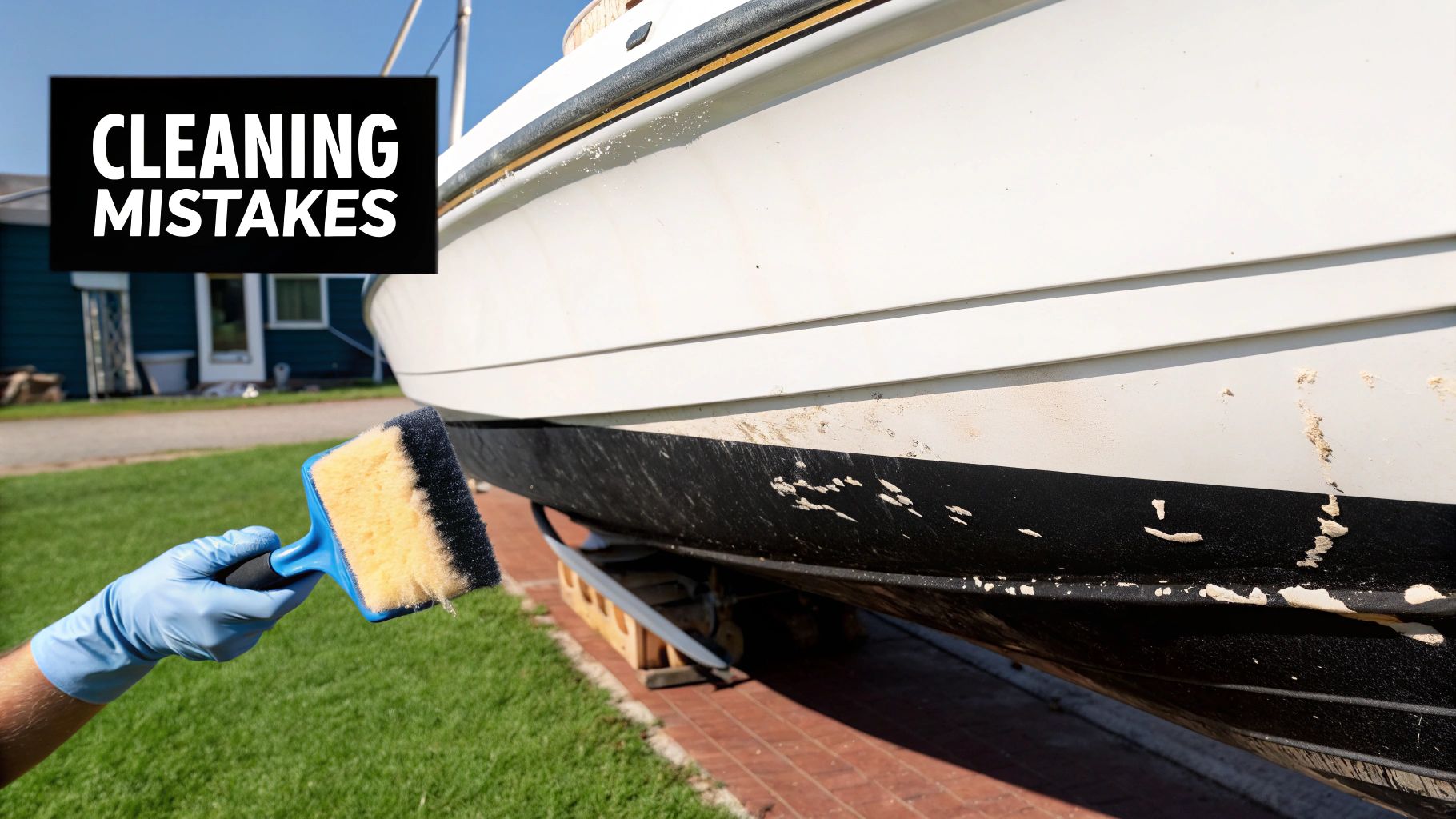
Even when you have the best intentions, it's surprisingly easy to make small mistakes that snowball into big, expensive problems for your boat's upholstery. I've seen it countless times. Knowing what not to do is just as critical as knowing the right way to clean.
Dodging these common pitfalls will save you a ton of cash on repairs down the road and keep your vinyl looking sharp for many seasons to come.
One of the most frequent errors I see is people reaching for the wrong cleaning tool. It’s so tempting to grab a kitchen scrub sponge or—even worse—a "magic eraser" for a stubborn scuff mark. While they might seem to work at first glance, on a microscopic level, they’re incredibly abrasive.
Think of them as super-fine sandpaper. They literally strip away the vinyl’s protective topcoat, leaving the surface dull, porous, and wide open to future stains and sun damage.
Another classic mistake is trying to clean your vinyl in direct, hot sunlight. The heat causes your boat vinyl cleaner to evaporate almost instantly, well before it gets a chance to break down the dirt and grime. This not only makes your job tougher but can also bake a sticky residue right onto the surface, creating a streaky mess that attracts even more dirt.
Overlooking the Finer Points of Your Technique
Aggressive scrubbing is another major culprit behind damaged vinyl. A lot of boat owners think that more elbow grease means a deeper clean, but for vinyl, the opposite is true. Using a stiff-bristled brush or just pushing way too hard can gouge permanent scratches into the material.
All you really need is a soft brush and gentle, circular motions to lift dirt from the grain without causing any harm. The key is to let the cleaner do the heavy lifting, not your muscles.
Just as damaging is the use of harsh, non-marine chemicals. I’ve seen people use household products with bleach or ammonia, and it's a disaster. These chemicals chemically attack the vinyl, stripping it of the essential plasticizers that keep it soft and pliable. Over time, this makes the material brittle and leads directly to cracking and splitting.
A crucial takeaway here is that vinyl care is a complete process, not just a single action. Simply cleaning the surface and calling it a day is a recipe for premature aging. That final step—applying a UV protectant—is absolutely non-negotiable for preserving your investment.
The Single Most Costly Mistake of All
Honestly, the most damaging mistake you can make is skipping the protection step entirely. After a good, deep cleaning, the pores of the vinyl are open and exposed. When you fail to apply a quality marine UV protectant, you're leaving it completely defenseless against the sun’s brutal rays.
This one oversight is what accelerates fading, drying, and eventual cracking more than anything else, drastically shortening the life of your beautiful upholstery.
Here’s a quick rundown of what to steer clear of:
- Abrasive Sponges and Pads: These will permanently ruin the vinyl's finish. Always stick to soft-bristle brushes and clean microfiber cloths.
- Cleaning in Direct Sun: Find some shade or wait for a cooler part of the day. This prevents the cleaner from drying too fast and leaving a nasty residue.
- Using Too Much Force: Scrub gently. Let the boat vinyl cleaner do its job breaking down the stains for you.
- Skipping the UV Protectant: This is the most vital step for long-term durability and keeping your vinyl's color vibrant.
By simply sidestepping these common errors, you can ensure your cleaning efforts actually preserve your boat's value instead of unintentionally destroying it.
Have a Question About Boat Vinyl Care?
Even the best-laid plans can hit a snag. When you're halfway through a cleaning job and a question pops into your head, you need a straight answer, fast. Here are the most common queries I hear from fellow boaters, answered directly to get you back on track.
How Often Should I Clean My Boat Vinyl Seats?
There's no single magic number here—it really comes down to how and where you use your boat.
For the average boater, a quick wipe-down with a gentle, pH-neutral boat vinyl cleaner every 2-4 weeks is plenty. This simple step stops everyday dirt and grime from getting a foothold.
At a minimum, you’ll want to do a deep clean and apply a fresh coat of UV protectant twice a year. I usually bake this into my spring commissioning and fall winterizing checklists. But if your boat spends its life in a harsh saltwater environment or gets a ton of traffic, you'll need to step up the frequency to keep that upholstery looking sharp.
Can I Use a Magic Eraser on Tough Vinyl Stains?
I get this question all the time, and my answer is always the same: absolutely not. It's incredibly tempting, I know, but you have to avoid magic erasers on marine vinyl.
They work because they’re essentially a block of super-fine sandpaper. Using one will literally scrub off the protective topcoat of your vinyl, leaving behind a dull, rough patch. Worse, that damaged area is now wide open to future stains, UV degradation, and cracking.
It's always better to grab a dedicated marine vinyl cleaner and a soft-bristle brush for those stubborn spots.
Expert Tip: If a regular cleaner isn't cutting it, reach for a specialized mildew or stain remover made specifically for marine vinyl. Let the product sit for the recommended time. The key is to let the chemicals break down the stain, rather than trying to muscle it off with brute force and abrasion.
What Is the Best Way to Remove Stubborn Mildew Stains?
For those ugly black mildew spots that just won't quit, you need to bring out the big guns: a cleaner specifically formulated to kill mold and mildew on boat vinyl.
Apply it right on the affected area and let it work its magic for the time specified on the bottle. Don't rush this part.
Then, give it a gentle scrub with a soft brush and rinse the whole area thoroughly with fresh water. If the stain is really deep-seated, you might need a second round. The most crucial step? Once the vinyl is completely clean and dry, slather on a quality UV protectant. This seals the material and makes it much harder for mildew to come back.
Are Household Cleaners Like Bleach or Dish Soap Safe?
Never, ever use common household cleaners on your boat's vinyl. Products with bleach or ammonia are the worst offenders—they strip the vinyl of its natural oils, making it brittle and prone to cracking in no time.
Even something as mild as dish soap is a bad idea. It can strip away the plasticizers that keep the vinyl soft and flexible. Stick with a pH-balanced, marine-specific boat vinyl cleaner. It’s the only way to be sure you're cleaning effectively without causing long-term damage to your investment.
Ready to treat your boat's vinyl to the care it deserves? The complete line of marine-grade cleaning and protection products from Better Boat is engineered to deliver flawless results, safely and easily. Find everything you need to keep your vessel looking its absolute best at https://www.betterboat.com.


